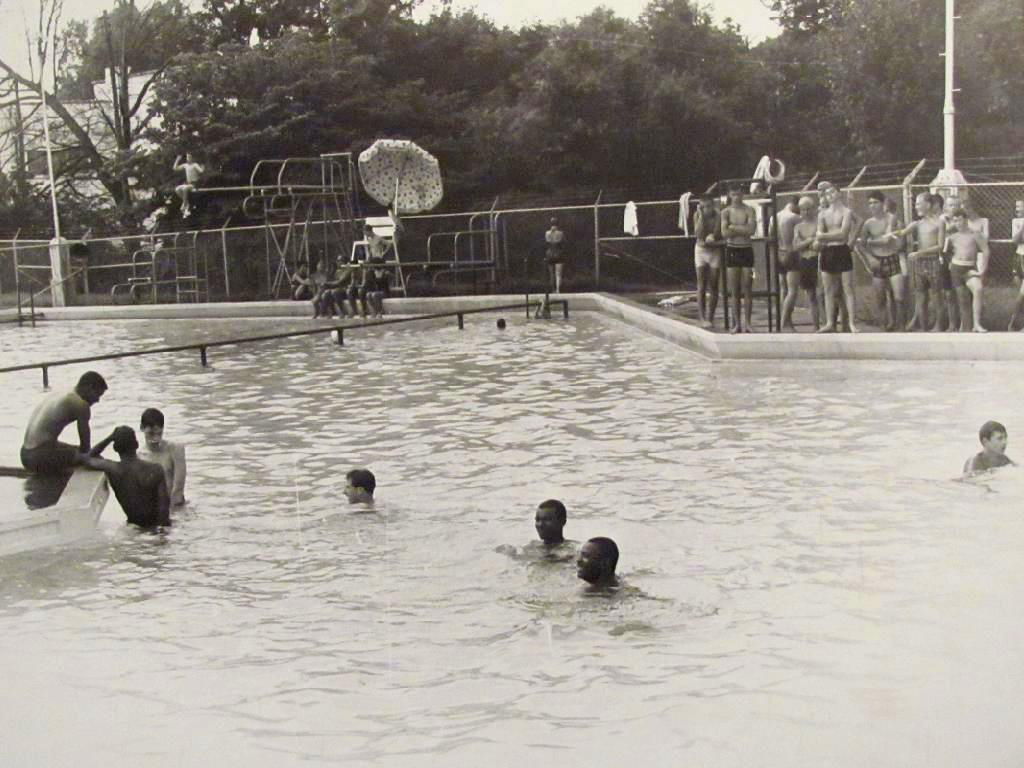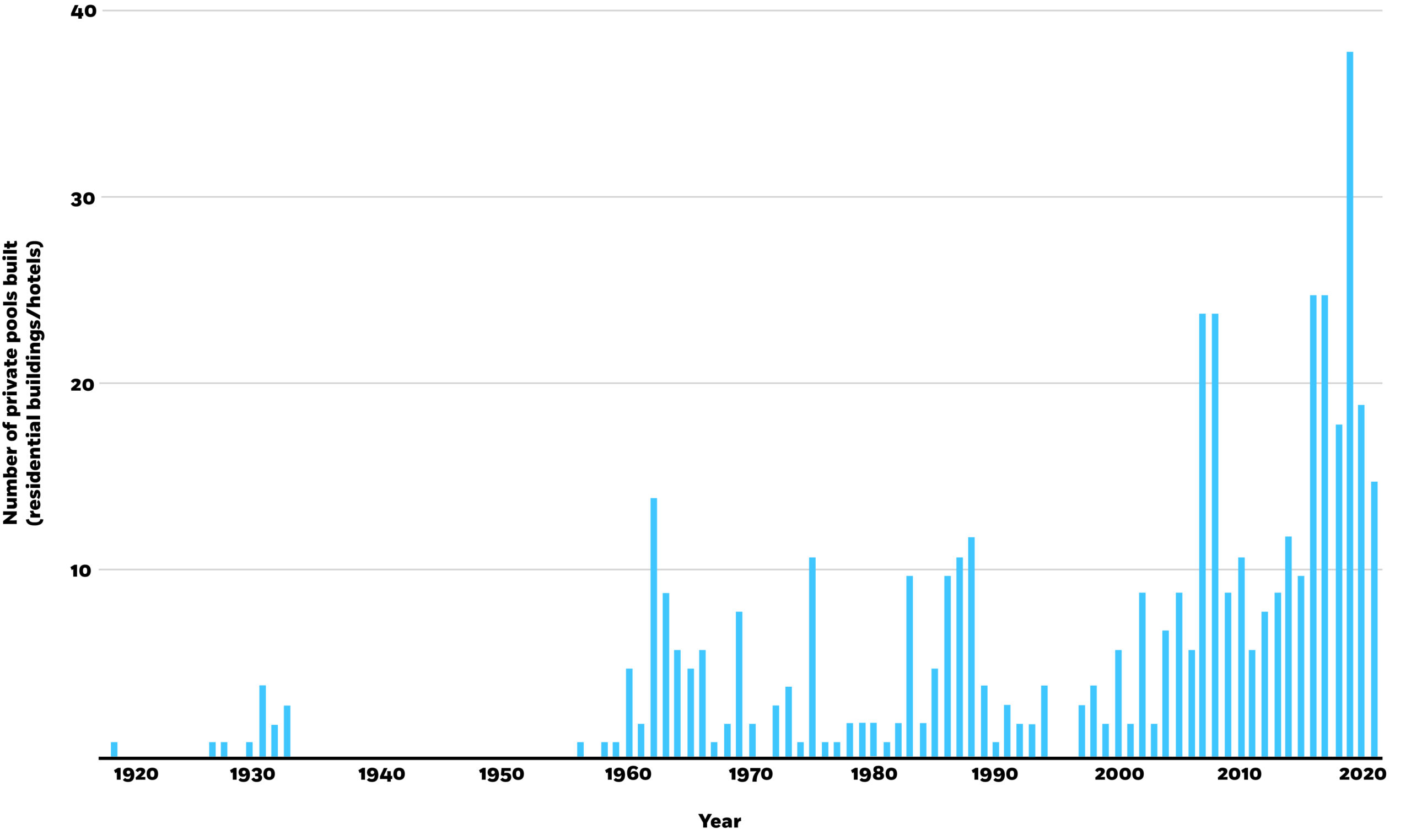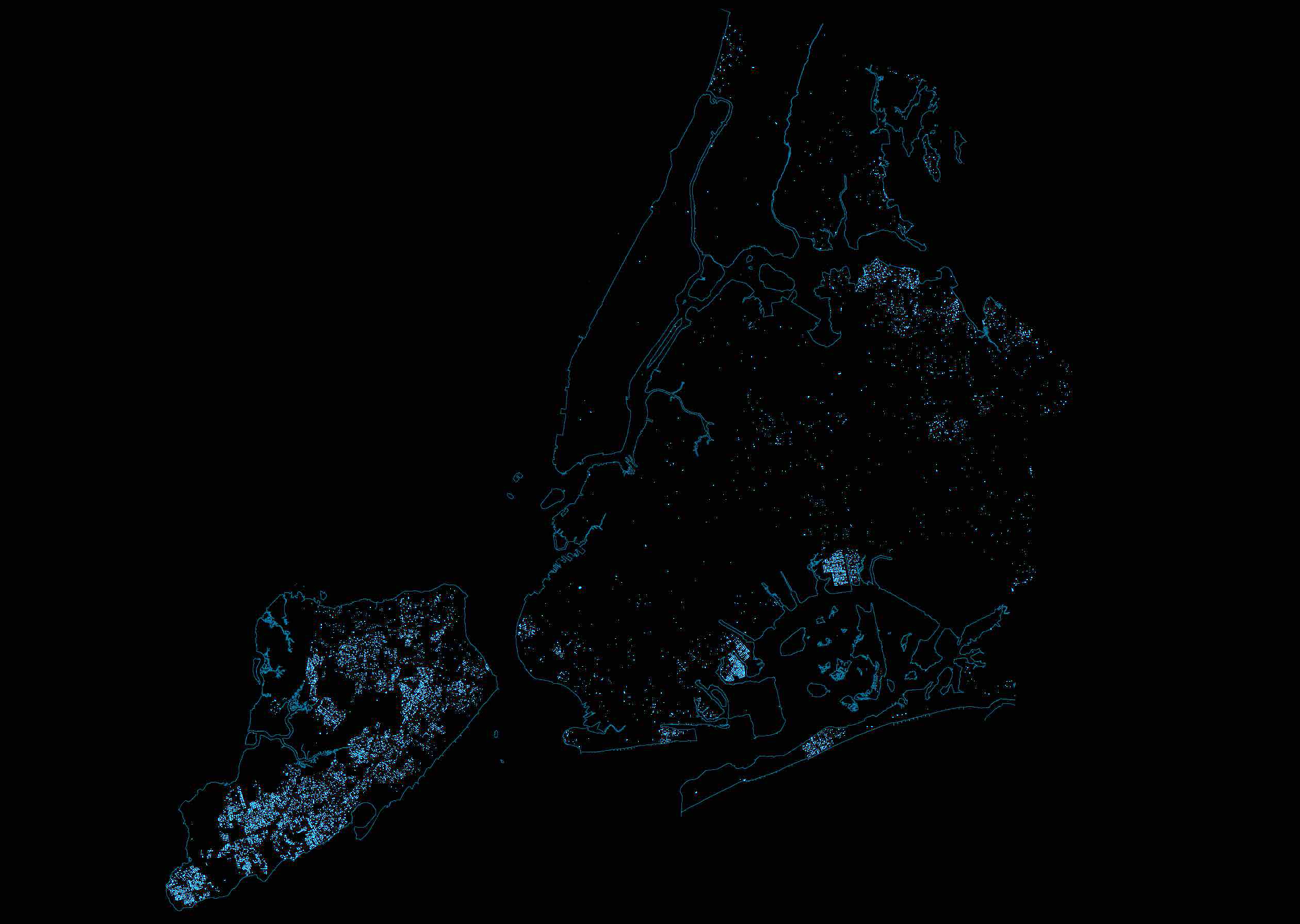
We are celebrating 15 years — and counting — of stories that are deeply researched and deeply felt, that build a historical record of what the city has been.
We are celebrating 15 years — and counting — of stories that are deeply researched and deeply felt, that build a historical record of what the city has been.
As summer moves all too swiftly into fall, we would like to offer a humble public service announcement: Go visit one of New York City’s public pools, before it’s too late! September 12 will mark the end of a fleeting outdoor swim season, and the city’s panoply of public facilities are not to be taken for granted. But for many New Yorkers, the weather poses no such limits (in theory, at least). Tucked away in towers or behind fences, private pools are surprisingly ubiquitous throughout the five boroughs, if somewhat shrouded in mystery — and many of their owners likely want to keep it that way. At the same time, these “amenities” are a crucial selling point for single family houses, luxury high rises, hotels, and private clubs. Spurred by architect Karolina Czeczek’s recent explorations of the infrastructural and social undercurrents of the city’s shared swim spots, our friends at the New York Review of Architecture posed the question: Why does New York no longer build public pools? Nicolas Kemper and A.L. Hu expand on this inquiry below, tracing the increasing prevalence of city pools as private property. Behind this shift lie changing attitudes toward sharing in public life and public goods, in a metropolis of both legendary luxuries and staggering inequities.
From 1900 to 1972, New York City built dozens of public pools. Since 1972, the city has completed just five. What happened? One of the city’s last new, outdoor public pools, the Floating Pool Lady, was completed — or rather docked — at Brooklyn Bridge Park in 2007. Built on a barge, in 2008, the pool moved up to Barretto Point Park in the Bronx, where it remains to this day. For Jonathan Kirschenfeld, the Floating Pool Lady’s architect, “the pool was only part of what we were creating. What we really were creating was a public space. If you look at the actual pool, it only takes up a third of the barge. I think that was an indication of our priorities: to create a gathering place, a mixer.”
That commitment to pools as a place for civic mixing used to be held by communities across the country. As Heather McGhee describes in her book, The Sum of Us, in the early twentieth century, public pools were the in thing. Towns saw pools not merely as an excellent way for people to cool down, but as focal points for civic pride — and even foundries for civil society. McGhee quotes a county recreation director in Pennsylvania: “Let’s build bigger, better and finer pools. That’s real democracy. Take away the sham and hypocrisy of clothes, don a swimsuit, and we’re all the same.”
McGhee argues that this enthusiasm came to an end when the term “public” was expanded to include everyone. Across the country, whether by law or by custom, public pools had been racially segregated. As McGhee explains, children excluded from public facilities were forced to escape the summer heat by swimming in dangerous rivers. While public pools were only officially desegregated by Title III of the Civil Rights Act in 1964, repeated drownings had already propelled a series of legal cases throughout the 1950s which led certain communities to desegregate facilities. Yet many of these communities almost immediately began to close or sell their public pools rather than follow through on integration. At the Fairground Park Pool in St. Louis, one of the largest pools in the world, violent rioting accompanied the first day of desegregated swimming on June 21, 1949. Plummeting attendance led to its closure six years later. This scorched earth approach won legal approval when, in the 1971 civil rights case Palmer v. Thompson, the Supreme Court ruled that the closure of pools in Jackson, Mississippi had harmed everyone equally. Justice Hugo Black wrote, “There was no evidence of state action affecting Negroes differently from white.” As communities closed their public pools, there was a rush to build new private pools in backyards and clubs across the nation.
If the same trend held true for New York City, it would have ceased building public pools in the 1960s, and there would have been a boom in private pool construction. At first, during the administration of Mayor John Lindsay (1966-1973), the city bucked the trend towards racially-motivated public pool closures. Not only did the Lindsay administration keep existing pools open, it actually built a fleet of dozens of “vest-pocket” and mini-pools deployed across the five boroughs. Meanwhile, however, private pool construction began to explode.
While a few clubs and hotels, including the Hotel St. George in Brooklyn, the New York Athletic Club, and the Downtown Athletic Club, all built spectacular pools contemporaneously with New York’s push in the 1930s to build public swimming facilities funded by the Works Progress Administration, the private sector only built about a dozen residential buildings with pools during the same decade. This changed in the 1960s: from 1960 to 1972, various developers built 63 towers with pools. Unlike Mayor Lindsay’s efforts, this boom in pool-building would be sustained and even accelerate. From 1973 to 2021, developers completed another 396 buildings with private pools.
Was the boom in residential pool construction racially motivated? Possibly not. People used to go to public baths for their everyday hygiene needs; but then plumbing happened, and now most of us use private showers. We used to go to public theaters, and now we stream Netflix on our laptops — pools could be viewed as just one more front in the conquest of the public by the domestic. That said, when we looked up 1960s-era advertisements for buildings with pools in the Avery Architectural and Fine Arts Library’s archive of real estate brochures, race did appear to play a role. In the brochure for one of the very first private rooftop pools, Gracie Towers on 180 East End Avenue — designed by Sylvan Bien and Phillip Birnbaum (a prolific New York architect who actually claimed rooftop pools as his own “innovation”) and opened in 1960 — there is no “whites-only” sign, yet the document prominently features an idyllic rendering of a pool filled entirely with white people. In fact, in every advertising brochure we could find from this period, all emphasize the privacy of these pools (generally indoors, on a roof, or behind a fence), and feature swimmers who are predominantly, if not entirely, white (though the rendering technique sometimes creates ambiguity). In contrast with today’s real estate advertisements, which often feature pools entirely without people, advertisements from the 1960s seem to show pools as the central node of bustling (whites-only) communities.
We do not have construction dates for every backyard pool in New York, but chances are very few of them predate the 1950s. According to a 1956 New York Times article, titled “They’re All Swimming in the Backyard,” until 1952 there were fewer than 15,000 private family pools in the entire country. Our dataset, assembled primarily from ArcGIS, shows that today there are 14,420 surface pools in New York city alone. These pools are clustered in neighborhoods that were predominantly built after the 1950s, such as Mill Basin in Brooklyn, largely developed from the 1950s through the 1970s, and Tottenville in Staten Island, which saw significant growth starting in the 1990s. As of the 2010 census, Mill Basin was 74 percent white, and Tottenville was 84 percent white.
The thesis of McGhee’s book is that structural racism is often bad for just about everyone, especially when it leads to defunding public goods (even for people with backyard pools). “The big disadvantage” of private pools, says Kirschenfeld, “is they are small, and you only meet people you know.” Yet private pools, and particularly backyard pools, are also in fact quite dangerous, simply because they do not have lifeguards keeping watch. According to the Center for Disease Control, drowning is one of the leading causes of death for children ages one through four in the United States; most of those drowning incidents happen in swimming pools, and most of those swimming pools are private. An American Public Health Association study of 678 pool-related drowning deaths in the US provides some direction on where drownings happen. This study organized drowning deaths according to pool type: public (37%), neighborhood (21%), and residential (35%). While the term “neighborhood” refers to pools affiliated with housing complexes, and the “residential” category refers clearly to backyard pools — both intrinsically private — the use of the word “public” is a little confusing, as the category includes hotel and motel pools, which account for 54% of “public” pool drownings.
Of course, there are considerable financial costs to private pools as well. There are two dominant materials used in pool construction: concrete (applied via shotcrete or gunite) and steel. Shotcrete is the overwhelming favored material for backyard and “in ground” pools, but it comes with some disadvantages for elevated construction. Whereas shotcrete is applied on site, leaving the success of a project at the mercy of the contractor holding the hose, steel is built in sections elsewhere and then welded together on site, allowing for better quality control. Whereas with shotcrete, one needs to chip away at the excess concrete to access pipes or fitting, steel allows for constant and easy access, and is much lighter. Joel Trace, a local architect who specialized in pools (and worked on hundreds of pool projects across a forty-year career, including the Floating Pool Lady), believes that most of the city’s elevated private swimming facilities are made of steel. According to Thomas Schrantz of Aqua Design International, aquatic consultants for public and private projects, any pool not “in ground” will be more expensive (he estimates a 30% markup) and steel will be even more costly (totaling about $500-$600 a square foot). For this reason, most tower pools are in fact quite small, and therefore marketers generally avoid sharing information about their size. Even when they do, only the length dimension is typically shared, as the width of such pools is often quite narrow. The website for the 432 Park Avenue, for instance, simply states that the 2015 luxury supertall has a 75-foot lap pool — photos show a single lane pool with a very narrow stripe down the middle. Tower pools also require a structural “vault” to hold them up, an expense not included in Schrantz’s estimate. And for backyard pools, as even the New York Times article from 1956 was quick to point out, the structure itself is only part of the cost, as owners will also often purchase or install pool equipment, furniture, decks, fencing, and sometimes even a cafeteria or bar.
While New York allowed a few to fall into disrepair and close, to its credit, the City never shut down its public pools out of spite or prejudice (McCarren Park Pool was the temporary exception), and the government has stepped up its investments in public pools in recent years. The City spent $50 million to reopen McCarren Park Pool, renovated by Rogers Marvel Architects, in 2012; the Cool Pools program has upgraded 16 pools since 2018; and in 2021, the City will begin a $150 million renovation of the former Lasker Rink and Pool in Central Park, led by architect Susan T. Rodriguez. Just this May, the City granted a site to a second floating pool, the + POOL, designed by Dong-Ping Wong and Oana Stanescu. Yet since the + POOL was first proposed in 2010, developers have completed another 196 towers with private swimming facilities. While not built with public money per se, private development reflects public policy, infrastructure, and zoning decisions. As we debate new investments in public pools and weigh their costs, perhaps it is time to look at our city’s ongoing investment in private pools, and better weigh that cost too.
A version of this essay first appeared in the New York Review of Architecture.
The views expressed here are those of the authors only and do not reflect the position of The Architectural League of New York.


